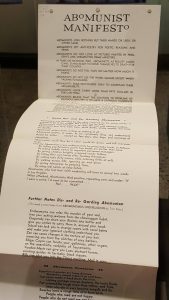I examined the case containing the “Abomunist Manifesto” and “What to do with the Boston Newsletter” by Bob Kaufman and Jack Spicer, respectively. I was initially drawn to the case simply due to the humor of the “Abomunist Manifesto.” I thought it was ridiculous that this completely sarcastic article, which appeared to be written as a joke, was now on display as a facet of history, so I took pictures out of sheer amusement. Upon revisiting these pictures at home, I realized how clever many of these commentaries were. One that stood out to me was “by biting their own hands after feeding themselves.” Many of these quotes were ambiguous enough to relate them to several instances in my daily life. This combined with the lighthearted tone made the article entertaining and original (I didn’t think anyone else would write about this case), which ultimately inspired me to write this blog post on it. Jack Spicer’s article was not as humorous to me and much less interesting so I focused primarily on the “Abomunist Manifesto.”
This case relates to Shakespeare’s “Sonnet 130” where he jokes about the features of his mistress until the couplet, where he affirms his love for her despite these imperfections. The tone of this sonnet is very similar to the “Abomunist Manifesto” in which Bob Kaufman writes that “Abomunism’s main function is to unite the soul with oatmeal cookies.” Instead of joking about a person like in Shakespeare’s sonnet, the “Abomunist Manifesto” jokes about contemporary objects, ideals, and customs.
The Beats exhibit certainly gave me an idea of how to structure my virtual exhibit. The red plaques next to each case are great examples of how to introduce an artifact. One theme I noticed was that the descriptions on these plaques did not explicitly describe the artifact but explained the relevant context behind its creation. For example, the case I explained above had a plaque describing the themes that Bob Kaufman valued during his writing career which he incorporated into the “Abomunist Manifesto.” In this way, the descriptions indirectly describe some of the intentions behind the artifacts but allow the viewer to create his own interpretation.
I was most curious about whether Kaufman employed a universal theme in the Manifesto apart from satire. I considered the possibility of him forming a political statement with this article since he did title it the “Abomunist Manifesto” which poked fun at the Communist Manifesto. I ultimately did notice a few political commentaries; however, they weren’t conjoined with a purpose other than to mock contemporary customs. I did a brief internet search to try and answer this but was unsuccessful, so I think a next step would be to do a more extensive search and probably email or call an expert on the Beats R evolution.
evolution.
